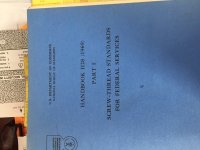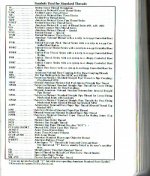Got to agree with JMFahey- only accurate way to do this is measure the outside diameter with a vernier caliper or micrometer.
When I was a young machinist apprentice, we spent lots of time using the H28 and calculating thread dimensions with a calculator.
Those days are over! The internet is loaded with websites that have thread calculators. But- you have to know the terms/names.
Here's one of my favorites:
UN imperial screw thread calculator
Otherwise, learn how many different threads there are, see second photo...
The threads shown in the first post are not self tapping, they are made like multi lead threads, fasten with less turns, stronger threads.
Most ME's I know (I are one), don't know much about electronics circuits. Most EE's don't know a lot about mechanical mechanisms, fasteners. You wouldn't believe some of the things I've overhead in the fastener aisle at some of the hardware stores.
There was even a professor at the school I work at teaching a CAD class who told students that the proper way to specify a thread was: 1/2-13 UNC +/-.005.
I sent him a message that it was wrong. It should be 1/2-13 UNC-2A. The two is the tolerance from a chart/Machinery's Handbook, and the A indicates an external thread.
Then you've got metric threads: M2 X 0.75 X length. Metric, 2.0mm nominal diameter, 0.75mm pitch (distance between threads).
Now, you can go to the hardware store and be somewhat conversational in fasteners. There is much more to it, but at least the store personnel won't be giving you the wrong information.
When I was a young machinist apprentice, we spent lots of time using the H28 and calculating thread dimensions with a calculator.
Those days are over! The internet is loaded with websites that have thread calculators. But- you have to know the terms/names.
Here's one of my favorites:
UN imperial screw thread calculator
Otherwise, learn how many different threads there are, see second photo...
The threads shown in the first post are not self tapping, they are made like multi lead threads, fasten with less turns, stronger threads.
Most ME's I know (I are one), don't know much about electronics circuits. Most EE's don't know a lot about mechanical mechanisms, fasteners. You wouldn't believe some of the things I've overhead in the fastener aisle at some of the hardware stores.
There was even a professor at the school I work at teaching a CAD class who told students that the proper way to specify a thread was: 1/2-13 UNC +/-.005.
I sent him a message that it was wrong. It should be 1/2-13 UNC-2A. The two is the tolerance from a chart/Machinery's Handbook, and the A indicates an external thread.
Then you've got metric threads: M2 X 0.75 X length. Metric, 2.0mm nominal diameter, 0.75mm pitch (distance between threads).
Now, you can go to the hardware store and be somewhat conversational in fasteners. There is much more to it, but at least the store personnel won't be giving you the wrong information.
Attachments
OP question.
... Is anybody able to tell me what this thread is so that I can find a tap for it?
You are telling us there is a tap for those screws? As Discopete said, good luck.Got to agree with JMFahey- only accurate way to do this is measure the outside diameter with a vernier caliper or micrometer.
When I was a young machinist apprentice, we spent lots of time using the H28 and calculating thread dimensions with a calculator...
When returning a sheet metal or wood screw to its hole, turn it backwards first, until it drops into the old threads. THEN tighten it. Don't cut fresh threads each time.


I think it is a bit of a pity that indra1 already cracked the jackpot by giving you the correct answer (there's no tap), because all that knowledge flowing in is sooo cool...
Negative, indra1.
I'm telling you that posting a photo of a fastener and asking people to tell you what type fastener it is, isn't an easy thing to do.
You need to give the nominal diameter, and pitch (Thread Per Inch or distance between crests in mm), and the root diameter just to know what type screw fastener you have.
Also, perusing a website about DIY electronics may not be the best place to learn about fasteners.
The fastener shown on the OP is a sheet metal screw. It is not self-tapping/self drilling screw. Self tapping screws have a pointed head or a drill shaped end. You don't need a tap or need to drill a hole.
I'm telling you that posting a photo of a fastener and asking people to tell you what type fastener it is, isn't an easy thing to do.
You need to give the nominal diameter, and pitch (Thread Per Inch or distance between crests in mm), and the root diameter just to know what type screw fastener you have.
Also, perusing a website about DIY electronics may not be the best place to learn about fasteners.
The fastener shown on the OP is a sheet metal screw. It is not self-tapping/self drilling screw. Self tapping screws have a pointed head or a drill shaped end. You don't need a tap or need to drill a hole.
Attachments
leftear- One thing for sure, I'm not going to go onto a DIY Audio website and show my ignorance about fasteners to look cool. Maybe that's what they do in your right ear?
Sadface- these type screw are installed at the factory by drilling a hole that is the same diameter as the root diameter of the fastener. In other words, there is no tap.
The fastener shown on the OP is a sheet metal screw. It is not self-tapping/self drilling screw. Self tapping screws have a pointed head or a drill shaped end. You don't need a tap or need to drill a hole.
Sheet metal screws are self-tapping, almost by definition. I also have self-tapping screws that have machine screw style blunt ends like these; they are not all pointed or self-drilling.
Get a copy of Kemps Engineers Yearbook, any year.
It lists every type of thread known to man, including dimensions and drawings; along with a million and one other engineering facts.
It lists every type of thread known to man, including dimensions and drawings; along with a million and one other engineering facts.
Not self tapping. Just sheet metal screws meant for thing metal that has already been drilled - that's why the threads are widely spaced. There is no tap for these, just a drill bit. As already pointed out many posts ago. Self tapping screws have a cutting edge that these do not.
You could tell just by looking?Sadface- these type screw are installed at the factory by drilling a hole that is the same diameter as the root diameter of the fastener. In other words, there is no tap.
Self tappers.
Sheet metal screw
Sheet metal screws (sometimes called "sheet-metal self-tappers", or P-K screws from the brand name Parker Kalon - who pioneered[7] the manufacture of, but did not invent, these screws) are a type of self-tapping screw despite the thread created in the sheet of metal being small. Pan-head PK Self-tapping screws are common in electrical equipment,[8] while flatter-headed truss or flat countersunk headed self-tapping screws[9] are more common in aviation applications.
Sheet metal screw
Sheet metal screws (sometimes called "sheet-metal self-tappers", or P-K screws from the brand name Parker Kalon - who pioneered[7] the manufacture of, but did not invent, these screws) are a type of self-tapping screw despite the thread created in the sheet of metal being small. Pan-head PK Self-tapping screws are common in electrical equipment,[8] while flatter-headed truss or flat countersunk headed self-tapping screws[9] are more common in aviation applications.
leftear- One thing for sure, I'm not going to go onto a DIY Audio website and show my ignorance about fasteners to look cool. Maybe that's what they do in your right ear?
How am i supposed to understand this? That you aren’t going to show your ignorance etc etc. or what?
Ok, you may have seen some of those screws before, probably more than I have.
But please, this is a DIY Audio website, and not a shady reddit-community, so please, stop being rude, arrogant, bullyish or whatever term you prefer to ennoble you with.
We weren’t even talking about the sound of resistors, so please, have some fun... it’s funnyer that way.
Oh, they *are* self tapping, just *one* of the many versions covered under that broad definition.
Check it yourself:
get a sheet of metal, punch (no drills involved there, too slow and dirty) a hole same diameter as screw core diameter.
We are talking a "cylindrical" body screw, constant diameter, as shown in first picture.
TRY to insert screw in said virgin hole, by hand or with a weak screwdriver.
Post results.
See? you can NOT.
Now take a stronger screwdriver, apply significant force/torque.
You will feel the sheet metal "give".
After that, you will be able to put screw in/out with very little force.
Congratulations, you have just tapped (threaded) that hole.
What tool did you use?
Just that screw?
Would you agree to ... ummmm .... call that screw "self tapping"?
It looks quite deserving of that name to me.
Also, as mentioned by Enzo, now you will have *one* position where it enters easily, in all others it will not, and if you are careless you will "strip" that hole, rendering it useless.
What are you destroying by being careless?
Would you call it "a tap" (thread)?
A tap which was not there before?
Which was created by that very screw?
Agree that there are other solutions to the self tapping problem, and let´s not get on the self drilling ones 🙂
Check it yourself:
get a sheet of metal, punch (no drills involved there, too slow and dirty) a hole same diameter as screw core diameter.
We are talking a "cylindrical" body screw, constant diameter, as shown in first picture.
TRY to insert screw in said virgin hole, by hand or with a weak screwdriver.
Post results.
See? you can NOT.
Now take a stronger screwdriver, apply significant force/torque.
You will feel the sheet metal "give".
After that, you will be able to put screw in/out with very little force.
Congratulations, you have just tapped (threaded) that hole.
What tool did you use?
Just that screw?
Would you agree to ... ummmm .... call that screw "self tapping"?
It looks quite deserving of that name to me.
Also, as mentioned by Enzo, now you will have *one* position where it enters easily, in all others it will not, and if you are careless you will "strip" that hole, rendering it useless.
What are you destroying by being careless?
Would you call it "a tap" (thread)?
A tap which was not there before?
Which was created by that very screw?
Agree that there are other solutions to the self tapping problem, and let´s not get on the self drilling ones 🙂
Last edited:
No, because it doesn't really cut any threads. The screw just traps two thin sheets of metal between its own widely spaced threads. There aren't any real threads in the metal.What tool did you use?
Just that screw?
Would you agree to ... ummmm .... call that screw "self tapping"?
Although in some of these you will see a sort of single thread cut into the metal that has depth. Still, does it really matter? They go into a hole in sheet metal and there is no tap for them. That's the important part, not what someone calls them.
I think you found the right hole...us!It's an anal thread, anyone can see that 😉
- Home
- Design & Build
- Parts
- Screw threads.



